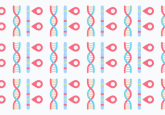Novel gene editor proves to be a pint-sized powerhouse

A compact CRISPR-based gene-editing enzyme, AsCas12f, has been developed, which is one-third the size of the widely used Cas9. AsCas12f was engineered to have ten times more editing ability than the original unmutated version, by combining selected mutations and its smaller size enables efficient delivery into cells via carrier viruses. Successful tests in mice have highlighted its potential for advanced genetic disorder treatments in the future.
CRISPR-Cas9 has been an incredible tool for snipping away unwanted genes and has been used to remove the genes that allow mosquitoes to carry malaria, enhance the nutritional value of food crops and, in recent years, it has been used in human trials to combat some of the most challenging genetic disorders. Typically, genetic material is introduced into host cells using modified viruses as carrier vectors, such as adeno-associated viruses (AAVs), as they are non-harmful to patients and can deliver CRISPR enzymes such as Cas9 into various cell types. AAVs also have a reduced risk of triggering unwanted immune responses compared to other techniques. However, the use of Cas9 and AAVs is limited by Cas9’s size:
“Cas9 is at the very limit of this size restriction, so there has been a demand for a smaller Cas protein that can be efficiently packaged into AAV and serve as a genome-editing tool,” explained Professor Osamu Nureki from the Department of Biological Sciences at the University of Tokyo (Japan).
Due to its large size, Cas9 can cause efficiency issues when used for gene therapy. This limitation led Nureki and his research team to develop the smaller Cas enzyme, AsCas12f, which is equally as active but has proven to be more efficient. AsCas12f is sourced from the bacteria Axidibacillus sulfuroxidans and improves on its predecessor as it is more compact and less than one-third the size of Cas9. However, in previous experiments, AsCas12f showed little to no genome activity in human cells.
“Using a screening method called deep mutational scanning, we assembled a library of potential new candidates by substituting each amino acid residue of AsCas12f with all 20 types of amino acids on which all life is based. From this, we identified over 200 mutations that enhanced genome-editing activity,” explained Nureki. “Based on insights gained from the structural analysis of AsCas12f, we selected and combined these enhanced-activity amino acid mutations to create a modified AsCas12f. This engineered AsCas12f has more than 10 times the genome-editing activity compared to the usual AsCas12f type and is comparable to Cas9, while maintaining a much smaller size.”
The research team has already performed animal trials, pairing AsCas12f with additional genes and administering it to live rodents. The successful animal experiments have indicated the engineered AsCas12f’s promise for use in human gene therapies, including treating conditions such as hemophilia, a disorder causing abnormal blood clotting.
Several potential combinations for enhancing the AsCas12f gene-editing system have already been identified, however, it has been noted that the chosen mutations might not have been the most optimal among the available mixes. In the future, computational modeling or machine learning could be employed to analyze the combinations and anticipate which yield superior improvements. Nureki further explained:
“Elevating AsCas12f to exhibit genome-editing activity comparable to that of Cas9 is a significant achievement and serves as a substantial step in the development of new, more compact genome-editing tools. For us the crucial aspect of gene therapy is its potential to genuinely help patients. Using the engineered AsCas12f we developed, our next challenge is to actually administer gene therapy to aid people suffering from genetic disorders.”






